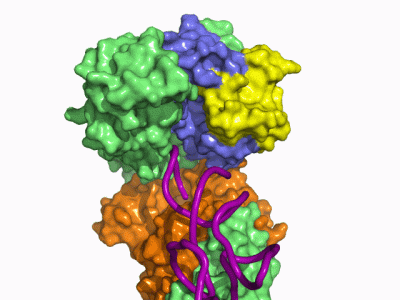Michael Ibba

Contact Information
Adjunct Professor and Interim Provost, Chapman University
Areas of Expertise
- Translation of the genetic code
- tRNA biology
Education
- B.S. Imperial College London, 1986
- Ph.D. University of Manchester, 1990
- Postdocs, Novartis, ETH Zurich, Yale University, 1990-1997
- Research Associate Professor, Copenhagen University, 1998-2001

Dr. Ibba's lab is not currently accepting students. To contact Dr. Michael Ibba, please use ibba@chapman.edu
Research Interests
Our research is directed towards understanding the mechanisms that determine how cells ensure the accurate translation of the genetic code, and how changes in the underlying processes impact cellular health and contribute to microbial pathogenesis and disease. Many of these processes are essential and unique to particular systems, making them ideal potential drug targets.
Quality control in protein synthesis
Ribosomes are the protein synthesis factories of the cell that translate the codons of mRNA into amino acids. Protein synthesis proceeds by delivery to the ribosome of aminoacyl-tRNAs, which pair with the corresponding mRNA sequences. Aminoacyl-tRNAs are made by the aminoacyl-tRNA synthetases, a family of twenty proteins each of which pairs a particular amino acid with the correct tRNA. Accurate aminoacyl-tRNA synthesis often requires an additional editing activity intrinsic to many aaRSs. The editing activity significantly decreases the level of mistakes in aminoacyl-tRNA synthesis in vitro and in vivo, although quantitative analysis of its contribution to the overall fidelity of translation has not been performed. The overall aim of our work is to develop experimental systems to quantitatively measure the frequency of aaRS-dependent misincorporation for several amino acids and evaluate the contribution of aaRS editing to overall translational fidelity in vivo.
Translational control of antibiotic resistance
In responses to different environmental stresses, such as the presence of antibiotics, microbes direct resources away from translation to a variety of pathways that contribute to resistance. Elongation factor P (EF-P). EF-P is a protein that mimics the structure and function of a tRNA and binds ribosomes. Aminoacylation of EF-P is required for optimal growth under a variety of conditions, for example at key points during Salmonella infection. We are interested in understanding how EF-P mimics tRNA at the molecular level and how this provides a novel mechanism for the post-transcriptional control of gene expression.
Memberships
Co-Director CMBP doctoral training Program
Associate Director Infectious Disease Institute
Selected Recent Publications
Steiner, R.E., Kyle, A.M. and Ibba, M. (2019) Oxidation of phenylalanyl-tRNA synthetase positively regulates translational quality control. Proc. Natl. Acad. Sci. USA. In Press.
Tollerson II, R., Witzky, A. and Ibba, M. (2018) Elongation factor P is required to maintain proteome homeostasis at high growth rate. Proc. Natl. Acad. Sci. USA. 115, 11072-11077.
Witzky, A., Hummels, K.R., Tollerson, R., Rajkovic, A., Jones, L.A., Kearns, D.B. and Ibba M. (2018) EF-P post-translational modification has variable impact on polyproline translation in Bacillus subtilis. mBio9, e00306-18.
Mohler, K., Mann, R., Kyle, A., Reynolds, N. and Ibba, M.(2018) Aminoacyl-tRNA quality control is required for efficient activation of the TOR pathway regulator Gln3p. RNA Biol. 15, 594-603.
Mohler, K. and Ibba, M. (2017) Translational Fidelity, Mistranslation, and the Cellular Responses to Stress. Nature Microbiol. 2:17117.
Rajkovic, A. and Ibba, M. (2017) Elongation Factor P and the Control of Translation Elongation. Annu. Rev. Microbiol. 8, 117-131.
Mohler, K., Mann, R., Bullwinkle, T., Hopkins, K., Hwang, L., Reynolds, N., Gassaway, B., Aerni, H., Rinehart, J., Polymenis, M., Faull, K., and Ibba, M. (2017) Editing of misaminoacylated tRNA controls the sensitivity of amino acid stress responses in Saccharomyces cerevisiae. Nucl. Acids Res.45, 3985-3996.
Elgamal, S., Artsimovitch, I. and Ibba, M.(2016) Maintenance of Transcription-Translation Coupling by Elongation Factor P. mBio7, e01373-16.
Moghal, A., Hwang, L., Faull, K. and Ibba, M.(2016) Multiple quality control pathways limit non-protein amino acid use by yeast cytoplasmic phenylalanyl-tRNA synthetase. J. Biol. Chem. 291, 15796-15805.
Rajkovic, A., Hummels, K.R., Witzky, A., Erickson, S., Gafken, P.R., Whitelegge, J.P., Faull, K.F., Kearns, D.B. and Ibba M. (2016) Translation control of swarming proficiency in Bacillus subtilis by 5-amino-pentanolylated elongation factor P. J. Biol. Chem. 291, 10976-10985.
Bullwinkle, T. and Ibba, M. (2016) Translation quality control is critical for bacterial responses to amino acid stress. Proc. Natl. Acad. Sci. USA.113, 2252-2257.
OTHER RELEVANT PUBLICATIONS
Rajkovic A, Erickson S, Witzky A, Branson OE, Seo J, Gafken PR, Frietas MA, Whitelegge JP, Faull KF, Navarre W, Darwin AJ and Ibba M. (2015) Cyclic rhamnosylated elongation factor P establishes antibiotic resistance in Pseudomonas aeruginosa. mBio 6 e00823-15.
Bullwinkle TJ, Reynolds NM, Raina M, Moghal A, Matsa E, Rajkovic A., Kayadibi H, Fazlollahi F, Ryan C, Howitz N, Faull K, Lazazzera BA and Ibba M. (2014) Oxidation of cellular amino acid pools leads to cytotoxic mistranslation of the genetic code. eLife e02501.
Elgamal S, Katz A, Hersch SJ, Newsom D, White P, Navarre WW and Ibba M. (2014) EF-P dependent pauses integrate proximal and distal signals during translation. PLoS Genetics 10 e1004553.
Bullwinkle TJ, Lazazzera BA and Ibba M. (2014) Quality control and infiltration of translation by amino acids outside of the genetic code. Annu. Rev. Genet. 48, 149-166.
Hersch SJ, Elgamal S, Katz A, Ibba M. and Navarre WW (2014) Translation initiation rate determines the impact of ribosome stalling on bacterial protein synthesis. J. Biol. Chem. 289, 28160-28171.
Shepherd J and Ibba M. (2014) Relaxed substrate specificity leads to extensive tRNA mischarging by Streptococcus pneumoniae class I and class II aminoacyl-tRNA synthetases. mBio 5, e01656-14.
Yadavalli SS and Ibba M. (2013) Selection of tRNA charging quality control mechanisms that increase mistranslation of the genetic code. Nucleic Acids Res. 41, 1104-1112.
Shepherd J and Ibba M. (2013) Lipid II-independent trans editing of mischarged tRNAs by the penicillin resistance factor MurM. J. Biol. Chem. 288, 25915-25923.
Elo, JM, Yadavalli SS, Euro L, Isohanni P, Götz A, Carroll C, Valanne L, Alkuraya FS, Uusimaa J, Paetau A, Caruso EM, Pihko H, Ibba M, Tyynismaa H & Suomalainen A (2012) Mitochondrial phenylalanyl-tRNA synthetase mutations underlie fatal infantile Alpers encephalopathy. Hum. Mol. Genet. 21, 4521-4529.
Roy H, Zou SB, Bullwinkle TJ, Wolfe BS, Gilreath MS, Forsyth CJ, Navarre WW & Ibba M (2011) The tRNA synthetase paralog PoxA modifies elongation factor-P with (R)-β-lysine. Nat. Chem. Biol. 7, 667-669. Nature Research Highlight. OSU news.
Reynolds NM, Lazazzera BA & Ibba M. (2010) Cellular mechanisms that control mistranslation. Nat Rev Microbiol 8, 849-856.
Weygand-Durasevic I & Ibba M. (2010) New roles for codon usage. Science 329, 1473-1474.
Roy H & Ibba M. (2010) Bridging the gap between ribosomal and non-ribosomal protein synthesis. Proc Natl Acad Sci USA 107, 14517-14518.
Navarre WW, Zou S, Roy H, Xie JL, Savchenko A, Singer A, Evdokimova E, Prost LR, Kumar R, Ibba M & Fang FC. (2010) PoxA, YjeK and elongation factor P coordinately modulate virulence and drug resistance in Salmonella enterica. Mol Cell 39, 209-221.
Reynolds NM, Ling J, Roy H, Banerjee R, Repasky SE, Hamel P & Ibba M. (2010) Cell-specific differences in the requirements for translational quality control. Proc Natl Acad Sci USA 107, 4063-4068..
Ling J, So BR, Yadavalli SS, Roy H, Shoji S, Fredrick K, Musier-Forsyth K & Ibba M. (2009) Resampling and editing of mischarged tRNA prior to translation elongation. Mol Cell 33, 654-660.
Roy H & Ibba M. (2008) RNA-dependent lipid remodeling by bacterial multiple peptide resistance factors. Proc Natl Acad Sci USA 105, 4667-4672.
Ling J, Roy H, Qin D, Rubio MA, Alfonzo JD, Fredrick K & Ibba M. (2007) Pathogenic mechanism of a human mitochondrial tRNAPhe mutation associated with MERRF syndrome. Proc Natl Acad Sci USA 104, 15299-15304.
Ling J, Roy H & Ibba M. (2007) Mechanism of tRNA-dependent editing in translational quality control. Proc Natl Acad Sci USA 104, 72-77.
Sauerwald A, Zhu W, Major TA, Roy H, Palioura S, Jahn D, Whitman W, Yates JR 3rd, Ibba M & Söll D. (2005) RNA-dependent cysteine biosynthesis in archaea. Science 307, 1969-1972.
Roy H, Ling J, Irnov and Ibba M. (2004) Post-transfer editing in vitro and in vivo by the beta-subunit of phenylalanyl-tRNA synthetase. EMBO J. 23, 4639-4648.
Jester B, Levengood J, Roy H, Ibba M & Devine K. (2003) Non-orthologous replacement of lysyl-tRNA synthetase prevents addition of lysine analogs to the genetic code. Proc Natl Acad Sci USA 100, 14351-14356.
Google Scholar
PubMed
